Growing Clematis terniflora ‘Paniculata’ or Sweet Autumn Clematis
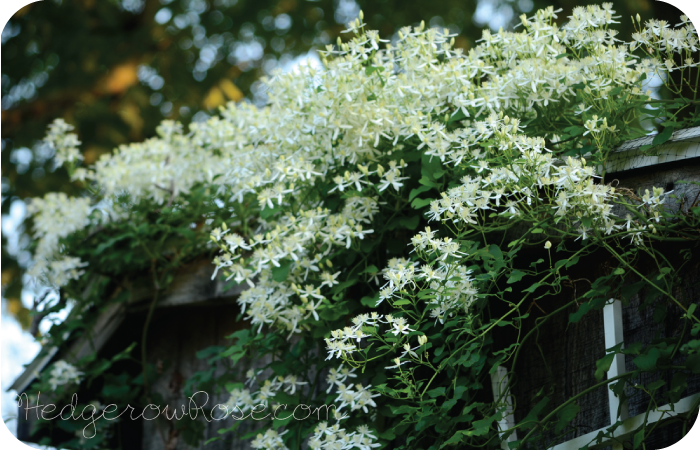
Clematis terniflora ‘Paniculata’
Sweet Autumn Clematis, officially known as Clematis terniflora or Clematis paniculata, is a gorgeous perennial vine which produces an abundance of sweet-smelling flowers late summer into early autumn. A rampant grower, and potentially invasive, I should have subtitled this post, “A Cautionary Tale” as it can easily overtake structures and spread, via it’s abundant whirligig seeds, into other parts of your (and perhaps your neighbors!) yard and garden.
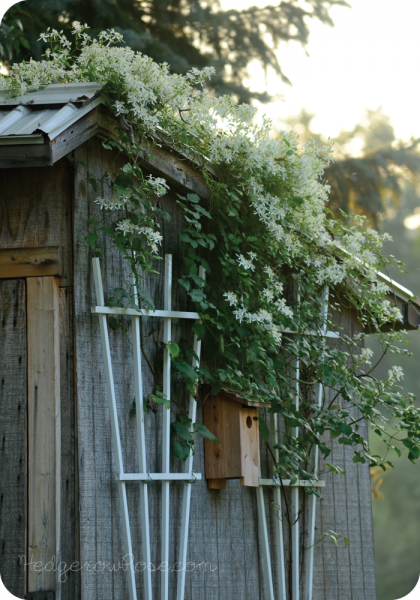 Our Sweet Autumn Clematis in it’s second year
Our Sweet Autumn Clematis in it’s second year
My husband and I are big fans of vining plants and are always looking for more ways to have our garden grow up. (Also, can anyone really have too many Clematis?) We knew we wanted to add Clematis paniculata to the garden and wisely took the advice of other gardeners who told us to beware the fast, thick growth, and to make sure to provide a very strong support. Additionally, we read about the potential for the seeds to spread to other areas of the garden, so we planted ours where it is surrounded by the lawn; any seedlings we don’t want can just be mowed when we cut the grass. Clematis paniculata can easily grow to heights of 30+ feet in just a few seasons, but this was part of the appeal when we selected this vine to cover the sides and roof of a shed in our yard. When we purchased ours in spring, 2010, it was barely 8″ high. The picture above was taken just a couple of weeks ago–that’s how fast this vine can grow!
 We attached bird netting to the roof of our shed so the leaf stems have something to grab onto.
We attached bird netting to the roof of our shed so the leaf stems have something to grab onto.
Of course, we know that clematis does not vine as, say, a pole bean, but actually curls it’s leaf stems around a support. These leaf stems are rather short and slender, therefore something needs to be provided for the leaf stems to grab onto that isn’t too thick. We attached bird netting to the roof of our shed (it’s lifted and supported underneath so there is space between the roof of the shed and the netting) and that seems to be doing the trick. Looking back, we should have also provided a similar support to the vine when it was smaller and still reaching up, but it still made it’s way to the roof with just a little support against a fan trellis attached to the side of the shed.
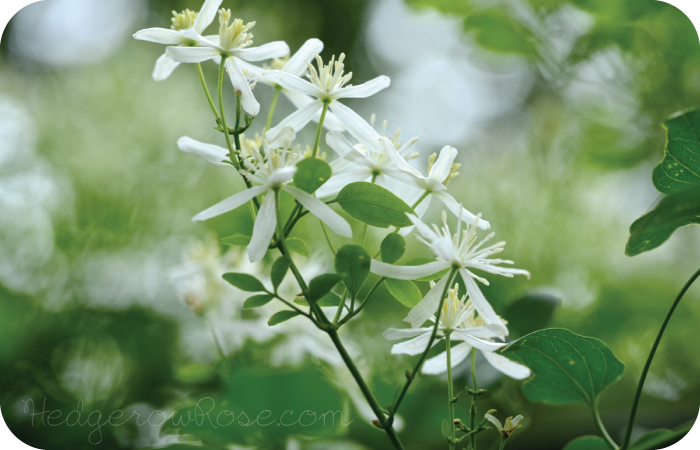
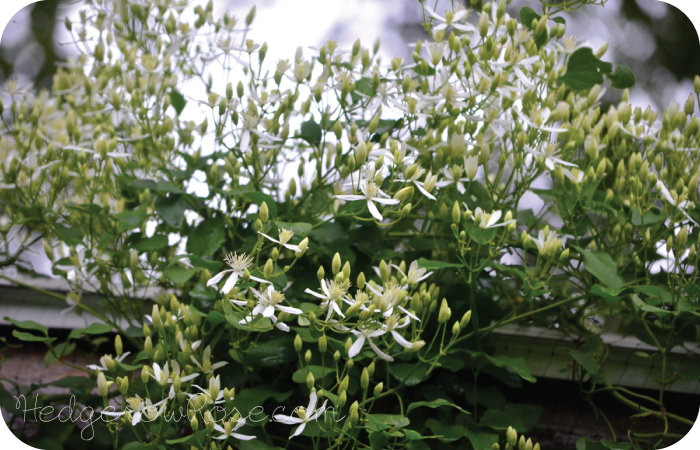
Clematis paniculata is part of Group III which means it blooms on new growth and can be pruned down to the base of the plant if necessary.
Clematis paniculata is hardy to zones 4-9 and prefers to have it’s “feet in the shade and face in the sun.” Planting other perennials and/or mulching around the base of the plant will help shade the shallow root system and keep them cool. Clematis vary in their pruning needs and are divided into 3 groups based on such. Clematis paniculata falls into Group III which means it blooms on new growth and can be pruned in early spring down to about 12″ high. This may be a good method for control if you’re worried about it taking over! Some gardeners even choose to prune in the fall before the flowers can set seeds, which might especially be a good option if you garden in an area where the potential for invasiveness is more severe.
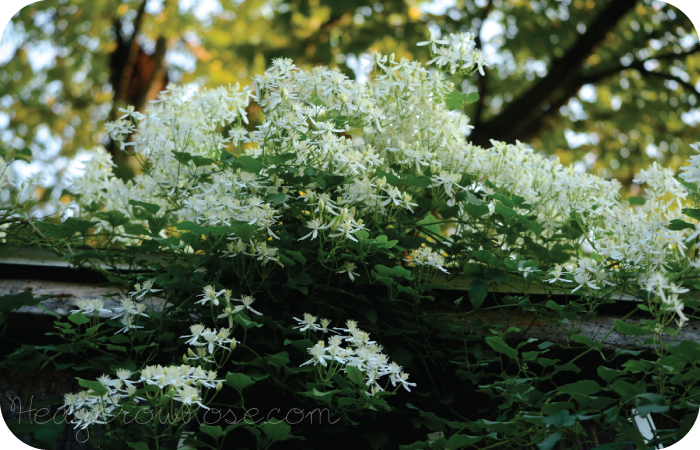
Clematis paniculata provides late-summer, early autumn nectar for bees and butterflies
Since we are only in our 2nd season with our Clematis paniculata, I am practicing a “wait and see” method of control at the moment. I’m thoroughly enjoying the look of our vine and it obviously hasn’t become a problem, yet. If it looks as though spread is going to be a concern, I will probably prune back immediately after flowering and control it’s size. If not, I plan on just letting it do it’s thing and envelope the roof of the shed providing a beautiful, scented backdrop in our late summer garden, and of course nectar for the bees!
EDIT: I can’t believe that I forgot to mention that Clematis terniflora is poisonous if ingested and some have experienced skin irritation when handling the plant. Obviously I have never poisoned myself with it, and we have an older child we aren’t worrying about popping seeds into her mouth. I have never experienced skin irritation, nor has my husband, but it wouldn’t hurt to wear a pair of gardening gloves if you have sensitive skin.


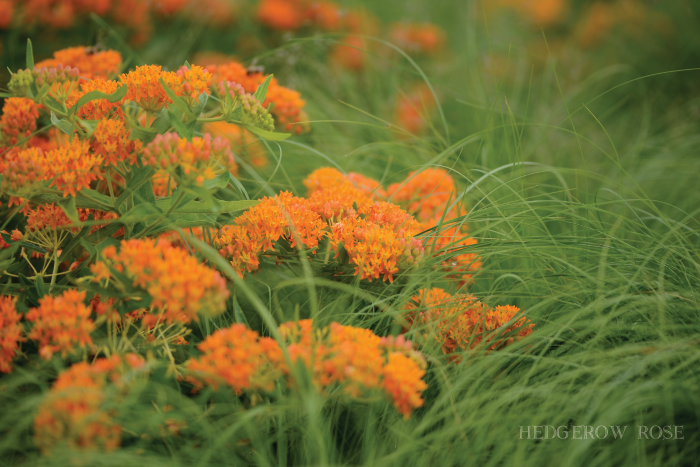
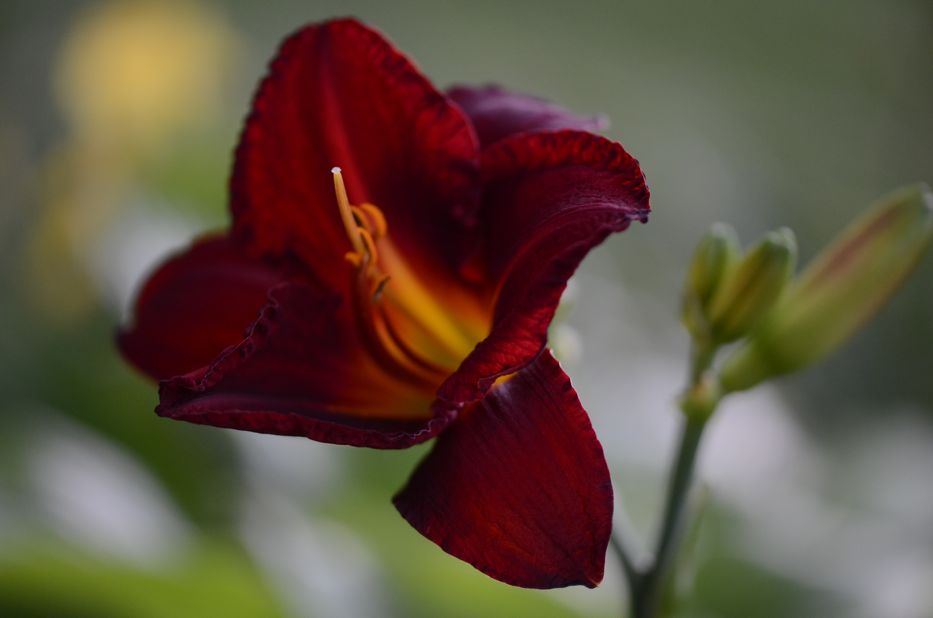
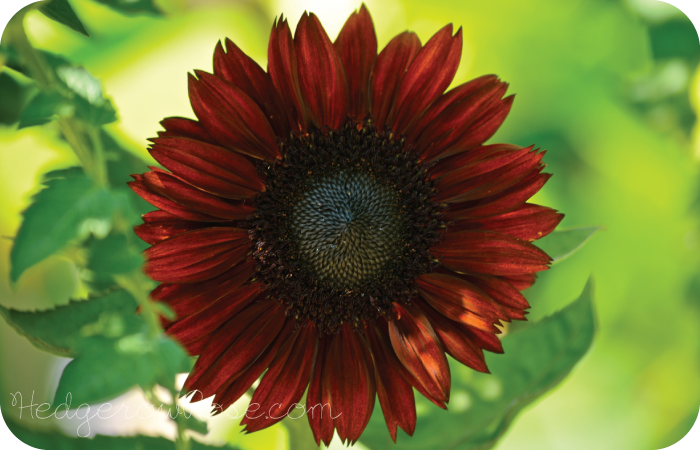
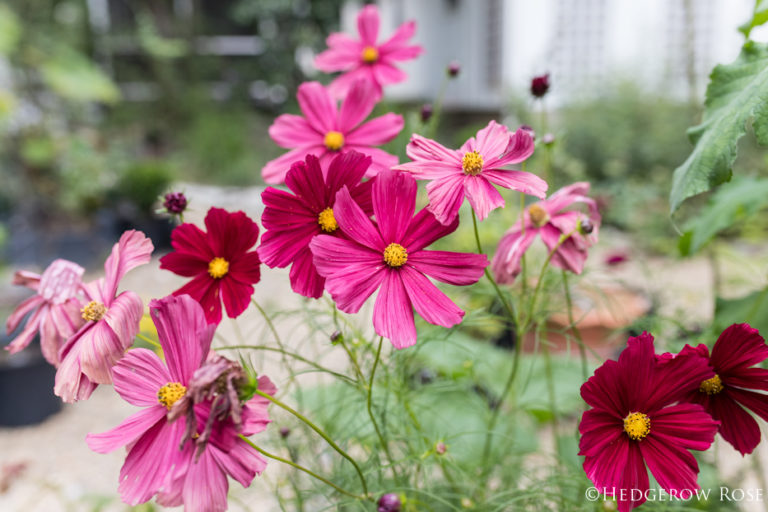
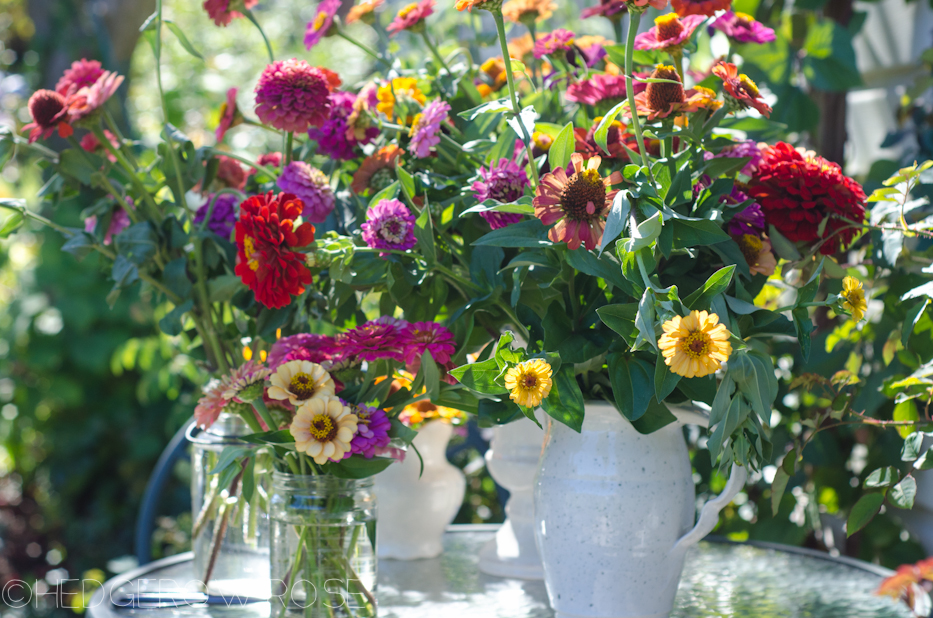
So appreciate this post. This beautiful clematis has been on my list of must-haves for next year. Thank you for the wonderful care-guide and gorgeous photos!
Thank you Laurie! I forgot to mention that we purchased ours through White Flower Farm. Here’s the link: http://www.whiteflowerfarm.com/26630-product.html You’ll see some customers complained about the invasiveness, and others loved their plant. Also, if you order from them, don’t be alarmed at the small size of the vine when you receive it. Believe me, it won’t take long for it to get big!
Absolutely love this clematis and it’s wonderful display of dainty white flowers! I too am a Clematis lover…I just planted 25 in my garden this year. Love all your beautiful pics and info.
Good gracious that is a lot of clematis! Your garden must look like a fairy tale!
Thanks for your post. Just found an almost 2′ wide patch of this growing in my front yard. I had no idea what it was, but smelled the flowers and knew I had to find out! Now I’m trying to decide the best place to transplant it to! Any transplanting suggestions?
Hi Laura! Glad this post helped. My grandmother used to tell me that if you want to transplant or divide a perennial, it’s best to remember when it blooms. For example, a spring blooming bleeding heart is best lifted and divided the previous fall and a fall blooming aster the previous spring. But to take it one step further, a good general rule of thumb is to transplant while the plant is still dormant, to avoid transplant shock, which in our area is sometime late March/early April, at the end of winter and into spring. To move your clematis, now might not be the best time since it’s probably already getting ready to bloom, but if you need to, I would make sure to do so when it’s not blazing hot (say early morning or evening), well water it first and try to dig up as much of the root ball as possible without disturbing the soil clinging to the roots. Move to a pre-dug hole that’s a little wider than the root ball so you can back fill it will some good compost and water in well. For a really good description of how to transplant a clematis “the right way” I found this post to be helpful. Good luck!
My grandmother used to tell me that if you want to transplant or divide a perennial, it’s best to remember when it blooms. For example, a spring blooming bleeding heart is best lifted and divided the previous fall and a fall blooming aster the previous spring. But to take it one step further, a good general rule of thumb is to transplant while the plant is still dormant, to avoid transplant shock, which in our area is sometime late March/early April, at the end of winter and into spring. To move your clematis, now might not be the best time since it’s probably already getting ready to bloom, but if you need to, I would make sure to do so when it’s not blazing hot (say early morning or evening), well water it first and try to dig up as much of the root ball as possible without disturbing the soil clinging to the roots. Move to a pre-dug hole that’s a little wider than the root ball so you can back fill it will some good compost and water in well. For a really good description of how to transplant a clematis “the right way” I found this post to be helpful. Good luck!
Is this clematis evergreen? I want something to cover an ugly chainlink fence. Think this would work?
It isn’t evergreen in our climate (we’re in zone 6) but as for covering a chain link fence I could see that working nicely. In fact I found this photo of “Sweet Autumn clematis covering a chain link fence” on Dave’s Garden that you might like to take a look at. Good luck!
Hi, Laurie
Thank you for the terrific advice and photos.
Because my older daughter wants a live arbor of white flowers at her outdoor wedding here in Maine this fall (September 6), I need to know if your Sweet Autumn Clematis (or anybody else’s) bloomed in its first season.
The White Flower Farms website says that first-year blooms are very unlikely. Is that your experience?
Thanks, in advance, for your help!
Chris
Appleton, Maine
Hi Chris! Congratulations on your daughter’s engagement!
We bought our clematis from WWF, too, and ours did bloom the very first year. It was still pretty small, though, definitely not big enough to cover an arbor. Have you considered a white morning glory instead?
Hi, again, Laurie
Thanks so much for your speedy, helpful reply. A white morning glory would work wonderfully (my daughter even mentioned it), except that so far, my research indicates that morning glories are summer bloomers.
I’ll renew my efforts and try to find a variety that’ll still produce flowers in early September. Any suggestions?
Thanks again,
Chris
Hi Chris, In our garden (Pennsylvania) our morning glories are late summer/early autumn bloomers and are going strong in September which is why I suggested it! My daughter and I call them “back to school flowers.” If I can think of anything else I will let you know!
My daughter and I call them “back to school flowers.” If I can think of anything else I will let you know!
I have been thinking of buying this beautiful clematis and am wondering if you think it would mix well with wisteria? We have two large trellis structures that could hold both plants, and I think the wisteria would bloom early and this particular clematis would bloom later. Or would they be fighting each other for space as well as scent?
Hi Paddy, my first thought is there would be too much competition from the Wisteria for the Clematis to really take hold. That being said, I’m always game to try things out just to see for myself. Perhaps you could designate a certain portion of the structure for the Clematis only–giving it ample space and nutrients to grow without being crowded out by the Wisteria. I found a garden forum that discusses this combination that you might find useful. Here’s the link. Good luck!
Perhaps you could designate a certain portion of the structure for the Clematis only–giving it ample space and nutrients to grow without being crowded out by the Wisteria. I found a garden forum that discusses this combination that you might find useful. Here’s the link. Good luck!
I have acquired some seed…any suggestions as to how early to start, indoors?, conditions etc. I’m in southwestern Ontario.
Gosh, growing Clematis from seed is something I’ve never tried before (I’ve only ever taken cuttings.) Have you tried posting your question to the GardenWeb forums? Someone there might be able to point you in the right direction. Good luck!
Do you know if sweet summer love clematis (similar to sweet autumn clematis, but earlier blooms and red & purple) can be grown in a large pot?
Hi Bonnie, I believe it can! You can see a photo of one grown in a container at this Proven Winners listing HERE. (click on “more photos.”) We planted one in our new garden last spring and it has been very slow to establish–not as much of a rampant grower as the sweet autumn clematis. Just something to keep in mind.
This plant is beautiful but last summer my fifteen pound Havanese dog got very ill. She had two lesions in her mouth and four open holes (lesions) on her flank. Her mouth became infected, She quit eating and despite the best of veterinary care ( I work at the vet’s), it took three months to recover. We weren’t sure she would survive
She is a healthy three year old. After hundreds of dollars of testing, we believe the cause was in gestation of the sweet clematis. Though her outside area is paved, there is vegetation coming through the fence
I’ve removed all of that and will be vigilant in the future. I hope this can help prevent some other dog from this scary experience.
Thank you, Karen, that is very kind of you to reach out and remind us all to be vigilant when it comes to protecting our little ones from plants with toxicity levels. I am so glad to hear your pup is feeling better!
I have a terniflora clematis growing in same spot where there was a purple clematis. Could it be the same plant?
That would be so strange. It’s more than likely the terniflora was brought there by birds or wind but that’s quite a mystery!
Clematis terniflora is a nonnative and INVASIVE species! It should not be sold in North America. It is also known as Autumn or Sweet Autumn clematis.
Our NATIVE fall blooming clematis is CLEMATIS VIRGINIANA or Virgins Bower clematis. THIS is what you should be selling!!
Hi Carolyn, thank you for your visit. I am NOT selling this clematis as I am not a plant nursery.
You may not have noticed that this is a blog post I wrote 13 years ago–from a garden I no longer tend–and I made a reference to White Flower Farm where I purchased that clematis back in 2011.
Even though, to your point, terniflora is no longer available from most reputable nurseries, I like to leave my older blog posts up and available to view as I have found that they are helpful to other gardeners.
I’d also like to warmly remind you, Carolyn, that when you’re leaving comments on the Internet, there is often a real, live person on the other end. Having a complete stranger shouting at me (completely unwarranted) first thing this morning when I opened my computer really made me feel awful.
I’m going to close comments now. But for those of you looking for the native Clematis virginiana, it can be found from Brushwood Nurseries HERE.